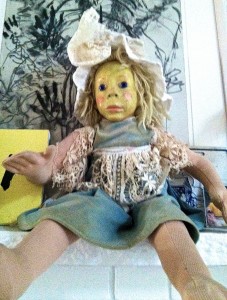
Recently, when I felt it was high time I write a poem or two and nothing was coming, my eyes fell on a line languishing at the bottom of a draft sitting on my desk. The line, “my hand teasing rough from the hypnotic smooth of nap,” had been cut from a poem I felt was tighter without it. In that poem, “Seedtime,” written about how April doles out the treasures of spring, the line was meant to extend the image of a lush, velvety lawn. But the image was already clear; the line, much as I liked it, was superfluous. I copied and pasted the abandoned line into a new Word file, compressing it as I did. The refashioned line, alone at the top of the computer screen, took on new life. It pulled me in an unexpected direction, to the interior, rather than the closely observed, exterior world in “Seedtime.” A new poem, “Tidal Impulses,” developed. More quixotic and sensual in tone and diction, it begins with this couplet:
Teasing the rough, coaxing hypnotic smooth,
Velour knows what little waves means, rises
I had upcycled my cast-off line into a new and better, whole-cloth poem. I was upwriting, and while I may or may not have coined that phrase, I certainly hadn’t invented the practice. Writers upwrite all the time, especially if they place narrative or syntactical integrity over attachment to an original impulse.

Refashioning scraps into something new and better is something I was exposed to long before the term “upcycling” came into vogue. My mother, born in rural Idaho in 1923, carried east with her a passion for sewing and a tradition, born of The Great Depression, of never throwing away anything that might have another use. Even if you couldn’t see a new purpose, one existed. She made summer play clothes for me out of a friend’s kitchen curtains. I can no longer recall the pattern or the color, but the outfits were comfortable and I loved that they matched. Using leftover dress fabric, she made clothes for my baby doll and my Sears and Roebuck Barbie, without a pattern. One of her most memorable feats might well have been the outfit she created from an overcoat my uncle had grown tired of. Made of thin wool, in robin’s egg blue, it was transformed into a toddler’s coat with classic lines. My mother lined it with gray, fine-wale corduroy and finished it with tiny pearled buttons. I wore the coat, then my younger brother did, and photographs reveal it looked neither boyish on me, nor girlish on my brother.
I still have most of the doll clothes —and the blue coat. More than that, though, I have a predisposition to refashion, to recycle. I see possibilities in things —deleted lines of poetry, pieces of cloth, scraps of wrapping paper— that only appear not to fit. I know they haven’t yet found their new purpose, a better expression. And I know it’s simply a matter of waiting —and listening.
—Jane Poirier Hart, Poetry Fellow

